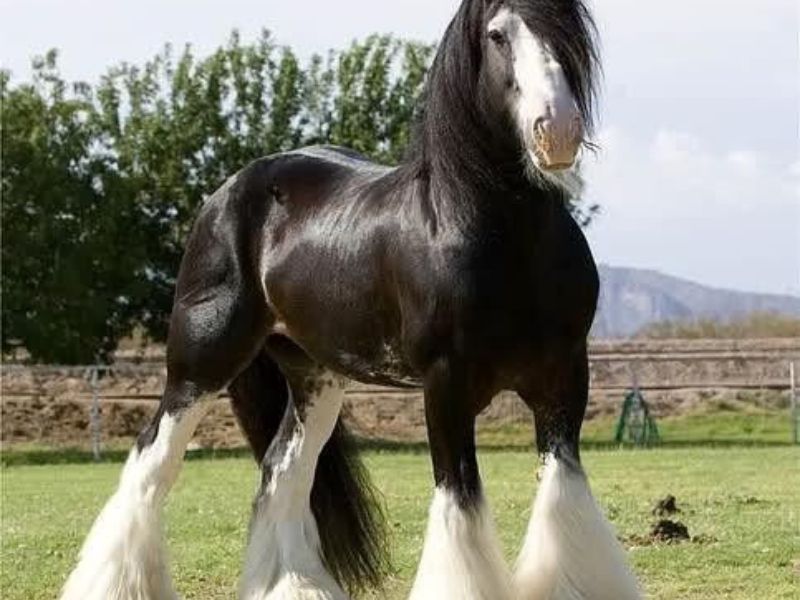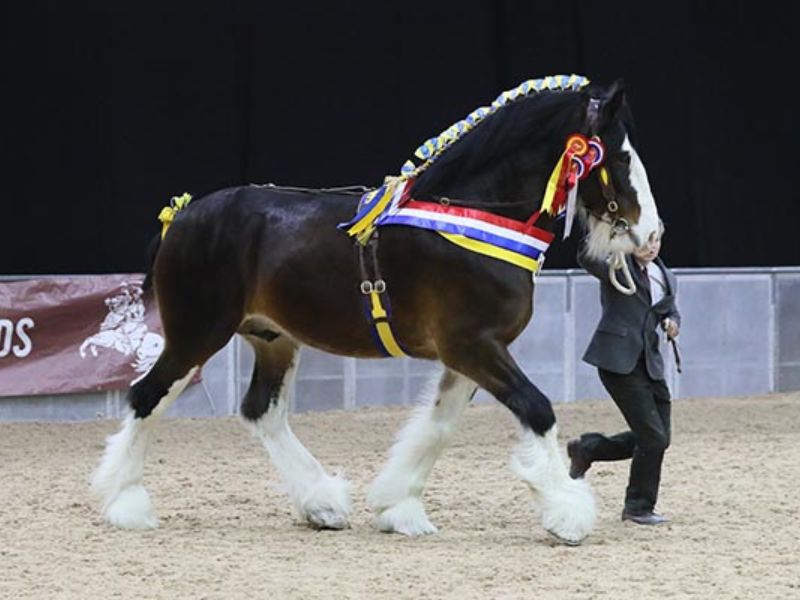It is very difficult for many horse enthusiasts to find the difference between the Shire and Clydesdale. These two are among the strongest and largest draft breeds in the United States. These popular horses have a rich history that sets them apart. These gentle giants were originally bred to pull heavy loads in agricultural and farm work.
The average Clydesdale stands about 16hh to 20hh tall and weighs around 1700 to 2500lbs. They have more distinct white markings on their lower legs, along with a refined build, a wide chest, and long feathers.
On the other hand, the Shire has a more muscular frame and comes in a wider range of colors, including bay, brown, gray, and black. While both breeds share a common past, they were formally distinguished about a century and a half ago, and are now classified separately as each type found its own path.
Having an informed understanding of their distinctions can really help when choosing the right breed. Everyone has their own reason for owning a horse, so by understanding their temperament, region, and heritage, you can make a more informed decision.
In this article, you’ll find deeply researched and accurate information about the Shire and Clydesdale that will help you understand the differences and similarities between these two amazing breeds.
Shire Vs Clydesdale: Comparision Table
| Feature | Shire Horse | Clydesdale Horse |
|---|---|---|
| Origin | England (medieval war horses → agricultural use) | Scotland (Clyde Valley, developed in 18th century) |
| Height | 17 – 19 hands (173 – 193 cm) | 16 – 18 hands (163 – 183 cm) |
| Weight | 1,800 – 2,400 lbs (800 – 1,100 kg) | 1,600 – 2,200 lbs (725 – 1,000 kg) |
| Coat Colors | Black, bay, brown, gray; minimal white markings | Bay, black, roan, chestnut; bold white blazes & socks |
| Feathering | Long, thick feathering on legs | Finer, silky feathering on lower legs |
| Temperament | Calm, gentle, obedient | Friendly, energetic, sociable |
| Lifespan | 20 – 25 years | 20 – 25 years |
| Conservation Status | At risk (Rare Breeds Survival Trust – UK) | Not at risk, but population relatively low |
| Typical Use | Logging, farm work, parades, ceremonial roles | Parades, pulling wagons, promotional teams, showing |
| Price Range | $2,500 – $20,000+ | $3,000 – $25,000+ |
Origins & History
Shire Horse Origin
The Shire and Clydesdale are the two powerhouse horses known for their strength, muscular build, and heavy conformation. The Shire horse originates from England and has deep roots in medieval times.
Around 1066, the Shire was used as a warhorse to carry knights in armor into battle. Their ancestry traces back to the English Great Horse, a foundation stallion used for battlehorse duties and agricultural needs across vast farmland.
Clydesdale Origin
In the 18th century, the Clydesdale was originated from the Clyde Valley of Lanarkshire, Scotland. The Packington Blind Horse was the most important stallion in their bloodline.
It was foaled in 1866 and is documented in historical records. The Shire registry was formed in 1876 and the Clydesdale Horse Society was formed in 1877. This shows that both breeds were developed close to the 19th century.
Breed Interaction
These workhorses were used for carrying, riding, and transport roles. But these draft horses were replaced and became less needed when their capabilities and roles were taken over by machines.
The breeders and preservation efforts helped them survive these difficult times. People like George Skinner, Ruth Skinner, and honorary president, Prince of Wales, helped in the revival of these two breeds in the 20th century and 1960s.
Organizations like the Rare Breeds Survival Trust helped to save the breeds when their numbers were low.
Their shared history and similarities make it easy to compare or differentiate these two breeds. The features, legacy, and influence show the unique journey that these two breeds have covered.
From crossbreeding to the inbreeding concerns, both horses have been bred, sculpted, and improved to survive. Today, these two are notable examples of historical value. It shows how two once-endangered giants were revived, popularized, and left a lasting mark on our world.
Physical Traits Compared
Height & Weight
When you see a Shire standing, you can easily understand why it is called the tallest draft breed in the world. It typically stands at 16 to 18 hands, but some individuals even exceed that. One notable horse was Sampson, aka The Mammoth, who was the largest horse ever, standing at 21.25 hands (1524 cm) back in the 1850s.
Clydesdales are also tall horses, ranging between 16 to 18 hands, but are slightly shorter on average. Their massive build, height, and powerful, strong, and impressive appearance make them easy to identify.
Shires are also heavier in weight than Clydesdales. Shires weigh from 1,800 to 2,200 pounds (around 800 to 1,000 kg), while Clydesdales are lighter, weighing between 700 to 1,000 kg.
Body & Feathering
Shire horses usually have a broader chest and a more defined croup. Their structure looks heavier due to their strong conformation.
Their back, tail set, and head give them a very distinctive angle, which can be seen prominently when the horse stands at rest. The tough Clydesdales come with finer bones, longer legs, and a more refined appearance. Desired traits like parallel hocks and a fine overall texture make their narrow legs high-set and strong.

Color & Markings
Now, let’s take a closer look at the colour and coat. Both Shires and Clydesdales have white feathering around their legs, which is one of their most sought-after features. Black, bay, and chestnut are common colours for both, but Clydesdales also show roan and grey shades in some regions.
Both breeds have markings on the face, hind, and bottom legs, but the white markings of Clydesdales can stretch up their body. Their hooves are large and strong, which adds to the imposing look of these heavy horses.
Temperament & Personality
The Shire and the Clydesdale are known for their calm demeanor, gentle nature, and workhorse reputation. Due to their steady, reliable, and easygoing nature, these draught breeds are best for heavy farm jobs. Their calm and composed temperament reflects their amazing personality.
For business, the Shire horse is more eager, focused, and truly unflappable. Their calm and hard-to-spook personality makes them perfect for pulling heavy loads or enjoying a relaxing ride. Their strong work ethic and willingness to respond well to commands make them ideal for beginner owners. These gentle giants are easy to train, always willing to perform well, and carry a docile, pleasant charm.
The Clydesdales are more energetic and playful than the Shire. Their cold-blooded, loyal, and dependable nature makes them perfect for parades and competitions. You’ll often see these obedient and iconic draft horses in various horse shows. They’re also considered ideal therapy horses, especially in stressful environments.
So here’s a fun way to see the difference: the Clydesdales are more adventurous and always ready to put their shoulder to the wheel, while the Shires are more nobly calm and carry a quiet confidence. They’re like a patient mentor, steady and composed through whatever the day brings.
Common Uses & Roles
Historical Roles
In the past, these two heavy breeds were used for hard labor and public service. They were used for heavy farm work, plowing fields, pulling barges along canals, and hauling brewery drays. Due to their massive strength and calm nature, both Shires and Clydesdales are ideal for physically demanding tasks.

Modern Roles
Today, both Shires and Clydesdales are more often seen in public-facing roles. They are used in show arenas, driving competitions, weddings, and parades. The Clydesdales are famous worldwide due to the iconic Super Bowl commercials.
Because of their gentle temperament, they are also popular for therapeutic riding programs. Both breeds are perfect for providing emotional or physical support to people.
Cost & Availability
Shires and Clydesdales have a similar price range, but some specific traits can impact the cost. Depending on age, training, bloodline, and intended use, the horse can typically cost between $2,000 to $20,000 or more.
Clydesdales are more in demand due to their popularity in advertising and media. Shires are more in demand because of their rare availability.
Pros & Cons Comparison Table
| Feature | Shire Horse | Clydesdale Horse |
|---|---|---|
| Size | Slightly taller and heavier | Slightly shorter, lighter build |
| Personality | Calm, steady, mentor-like | Playful, energetic, more animated |
| Cost | $2,000–$20,000+ | $2,000–$20,000+ |
| Health Needs | Prone to feathering-related skin issues | Also prone to feathering issues (like scratches) |
| Beginner Friendly | Very beginner-friendly, easy to train | Friendly but can be more spirited |
| Space Requirements | Requires large pasture and strong fencing | Similar needs, may adapt better to smaller farms |
Care & Health Considerations
Both Shires and Clydesdales require a lot of attention and horse care. You have to be big-hearted to provide them proper grooming, hoof care, and vet visits. Their feathered legs need to be cleaned regularly to avoid bacteria, fungi, and dirt.
After a bath, you need to fully dry the feathered legs to avoid irritation and infection. A proper care routine like brushing, trimming, and shoeing should be a rewarding part of the bond you share with your equine friend. It’s a big job, but it keeps your horse fit and healthy.
Shires and Clydesdales are more prone to health issues like chronic progressive lymphedema. It is a skin condition that can cause swelling in the legs. That’s why regular check-ups and veterinary care are essential to maintain their overall health.
You also need to manage their weight so it stays close to that of average-sized horses. Giving them a balanced diet with high-quality hay, grain, and vegetables ensures proper nutrition. It’s important to give them access to fresh water and vitamins as part of their horse diet. Regular veterinary care and proper management are vital to keep these large horses healthy.
Teeth cleaning is often overlooked, but it’s equally important in horse care. So special dental care is crucial, especially for novice riders. Due to their large size, they also need lots of space to move and stay healthy.
Which One is better Shire or Clydesdale?
Before choosing a horse, you need to consider a few things. Both horses require pasture space, a budget, and riding experience. It also depends on your use—whether it’s for farm work, shows, or just leisure.
Due to their calm and gentle nature, both are great choices for new riders. But Clydesdales are slightly more energetic due to their spirited and flashy demeanor. Shires are known for their quiet strength, steadfast presence, and suitability for farm work.
In terms of budget, Clydesdales have a higher price tag due to their popularity and show appeal. Meanwhile, Shires are more budget-friendly if you’re not looking to compete in events.
So if you want to compete in riding shows and events, go for a Clydesdale—the horse with energy and flair. But if you want a horse with quiet strength and presence, choose a Shire.
Shire Vs Clydesdale: Conclusion
Shire and Clydesdale horses are two of the most powerful draft breeds, known for their size and strength. Shires are considered the tallest and largest horse breed, while Clydesdales are famous for their striking white markings and the iconic Budweiser ad.
Shires are mostly found in black, bay, brown, and grey colors, while Clydesdales are typically bay with extensive white markings. Shire horses are often preferred for farm work and carriage pulling, whereas Clydesdales are more favored for public appearances like riding shows and events.
